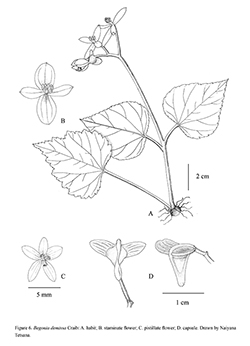e-Flora of Thailand
Volume 14 > Part 3 > Year 2019 > Page 373 > Begoniaceae > Begonia
10. Begonia demissa Craibwfo-0000823811
[§ Diploclinium], Bull. Misc. Inform. Kew 1930: 409. 1930; Craib, Fl. Siam. 1: 773. 1931; Hughes, Annot. Checkl. SE Asian Begonia. 33. 2008. Fig. 6. Plate XXXV: F–G.
Accepted Name : This is currently accepted.
Synonyms & Citations :
Description : Monoecious acaulescent herb, 8–20 cm tall. Stems tuberous, globose or subglobose with numerous fibrous roots, 4−10 mm diam. Leaves unifoliate; petiole dark red, brown whendry, 3−10 cm long; lamina basifixed, succulent, symmetric, chartaceous when dry, adaxialsurface glabrous, light bright green or dark green, abaxial surface glabrous, pale green or dark red, deltate to cordate, 2−15 by 2−10 cm, base truncate, apex acute, margin crenate or sinuate, venation palmate, veins 4−7, inconspicuous on both sides. Stipules caducous, pale green, lanceolate, 2−3 by 1−2 mm, apex acute, margin entire. Inflorescences axillary between a pair of leafy bracts, dichasial, branching 2−3 times, bisexual, 4−16 cm long, staminate flowers basal, pistillate flowers distal, protandrous; peduncles dark red near the base, then pale green, 2.5−12 cm long, terete, glabrous, glossy. Bracts leafy, 1-paired, 1.5−4.5 by 1−2 mm. Staminate flowers: pedicels pale green, 8−12 mm, ascending; tepals 4, plain white, obovate or oblanceolate, 5−6 by 2−3 mm, base cuneate, apex obtuse, margin entire, glabrous on both sides; androecium zygomorphic, stamens 10−11, bright yellow, filaments fused at base, ca 2 mm long, anthers oblong, 1−1.5 mm long, dehiscing by short pores near tip. Pistillate flowers: pedicels pale green, 4−6 mm long; tepals 4(−5), plain white or pale pink, glabrous on both side, subequal, outer 3 obovate, 3−4 by 1−2 mm, inner 1 oblanceolate, 3−4 by 1−2 mm, base cuneate, apex obtuse, margin entire, glabrous on both sides; styles 3, fused at base, bright yellow, stigmatic band kidney-shaped, minutely papillose; ovary pale green, 3-locular, with 3 subequal wings, placentae unilamellate. Fruit a dehiscent capsule, pale green, pendulous, drying pale brown, 5 by 6−7 mm with wings; locules ovate, 3−4 by 3−4 mm, abaxial wing narrowly oblong, once twisted, 4−5 mm long, ca 2 mm at base, 2 lateral wings orbicular, 4−5 mm long, 4−5 mm wide at base. Seeds brown, barrel-shaped, ellipsoidal or oblong, collar cells elongated, 4/5 of seed length.
Thailand : NORTHERN: Chiang Mai, Nan, Phitsanulok; PENINSULAR: Trang; SOUTH-WESTERN: Kanchanaburi (type: Put 218, syntypes -ABD BM K).
Distribution : Myanmar.
Ecology : On karst limestone cliffs in shaded areas with water seepage in seasonally dry evergreen forests, 100−600 m alt. Flowering: July–September; fruiting: September–December.
Vernacular : Som kung hin pun (ส้มกุ้งหินปูน).
Notes: Begonia demissa resembles B. brandisiana in fruit characters, but differs in having an axillary inflorescence, 4 tepals in staminate flowers (not 2), anthers opening by small pores and having 4–5 tepals (not 2) in the pistillate flowers.


